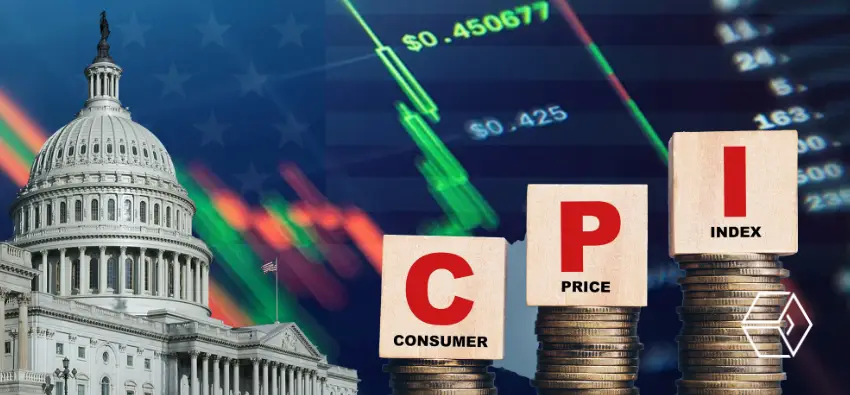
The monthly Consumer Price Index announcement never fails to move global markets. Whether stocks or crypto, all asset prices feel the ripples caused by the inflation gauge. Novices and old hands closely parse the CPI data, discerning if their holdings will flourish or founder on the back of it. A rising report stokes inflation worries, stirring waves of selling across Wall Street.
Cryptocurrencies, purported hedges against higher prices, plunge as many investors bail out. Yet CPI reports are often complex, as some coins counterintuitively climb in the inflationary model. Beneath the volatility, detecting patterns informs savvy players of cryptos’ true relationship with economic reports. They spot how different coins ebb and flow against macro tides. This article aims to reveal essential insights for confidently guiding investments in the crypto market through the choppy sea of statistics.
Understanding the Consumer Price Index report
The Consumer Price Index tracks shifts in consumer spending habits, inflation trends, and long-term economic health over the decades. However, the Bureau of Labor Statistics (BLS) publishes monthly reports to monitor price changes for a market basket of goods and services representing what the average American buys. Periodically, the basket is updated to account for consumer substitution of new choices for old.
The index helps gauge economic impacts, whether inflationary or deflationary, on household financial planning and the economy overall. It signifies how far current dollars stretch versus before. Policymakers consult the CPI when crafting monetary and fiscal responses to shifts in purchasing power. Overall, the CPI sheds light on trends in living expenses and the real value of incomes and benefits over time.
How the crypto market is impacted by CPI reports?
The Consumer Price Index report, which gauges inflation, carries enormous influence over the cryptocurrency sphere by altering sentiment, investor behavior, and how institutions devise their strategies. When the CPI indicates that inflation is rising, digital assets like Bitcoin and Ethereum frequently see price boosts attributable to their reputations as hedges against inflation. For example, between January and November of 2021, Bitcoin rocketed from approximately $29,000 to nearly $69,000, while Ethereum leaped from about $730 to in excess of $4,800 during the same span. In addition, cryptocurrencies like Solana, which have practical uses in the real world, saw substantial growth, soaring from approximately $1.50 to over $250 in 2021.
These surges were fueled by the market sentiment of future inflation worries, thereby skyrocketing demand for the coins, eventually leading to price rises in both cryptocurrencies and their exchanges. Heightened inflationary pressures or significant expected shifts in interest rate policy by the Federal Reserve often push investors to make bets on inflation-related investments in anticipation of making more profits. These often involve adjusting portfolio assets or trading tactics like quick buying or selling digital assets.
Crypto price rise predicted amid April CPI report
A potential momentum is anticipated within the cryptocurrency market, given the implications of veteran crypto analyst Peter Brandt’s bullish prediction of Bitcoin’s next all-time high amidst the recently published Consumer Price Index (CPI) report.
Further highlighting the increasing need for alternative stores of value to hedge against the value-depreciating nature of fiat currencies, CPI for All Urban Consumers reported a 0.3 percent gain in price levels, seasonally adjusted, with a one-year increase to 3.4 percent. For the overall cryptocurrency market, one could think of Bitcoin’s expected run as a light at the end of the tunnel, at the end of which a rejuvenated investor interest and confidence will be restored.
Bitcoin, which often sets the tone for market sentiment, could draw inflows into other digital asset classes as it marks a return to its highs, leading to a potential broader market rally. In addition, its price movement has already impacted the rest of the digital currency ecosystem as it continues to rank up the ladder, standing at $71,140.60 on June 5th at 7:18 a.m.
This increased visibility can only positively impact the market’s health, potentially increasing acceptance and paving the way for the long-term adoption of these assets. In conclusion, the bullish trend for Bitcoin, especially among those fearing inflation and the continuous devaluation of fiat, could spark good and secure developments in the same cryptocurrency market, all of which could offer customers a wider base to choose from to diversify and hold onto wealth.
Given that the most recent CPI reports have pointed to 0.3 percent seasonally adjusted inflation and a 3.4 percent year-on-year rise, investors will need to monitor closely how this trend may be developing in the May report. Due to the correlation between CPI data and cryptocurrency market performance, some investors may wait for the May CPI report before playing any big chess pieces in the crypto space.
Suppose the CPI data confirms consumer price inflation is picking up steam. In that case, this further inflation should also mean those cryptocurrency tokens (Ethereum, Litecoin, and even the “memecoin” Dogecoin) perceived as an inflation hedge will stand to benefit in a big way as a hedge against fiat devaluation.
Conversely, if the CPI data points to decreased inflation, investors will take less profit home. Investors looking into the crypto market should take into account not just CPI reports but also factors like policy interest rates and liquidity conditions before making any investment decisions.
Disclaimer – The information provided in this editorial is based on market trend analysis and patterns and should not be construed as financial advice. It does not guarantee any financial gain. All investments carry risk, and you should consult a qualified financial advisor before making investment decisions.











